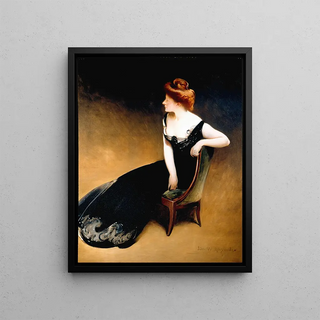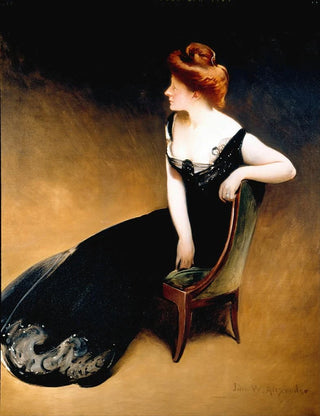Art print | Portrait of Mme V. Mme Herman Duryea - John White Alexander


View from behind

Frame (optional)
In the fascinating universe of art, some works manage to capture the very essence of humanity through the lens of a gaze. "Portrait of Mrs. V. Mrs. Herman Duryea" by John White Alexander is one of those creations that transcends the simple frame to offer an immersion into the intimacy of a moment frozen in time. This piece, imbued with delicacy and depth, invites us to explore the psyche of its subject while celebrating the technical mastery of the artist. Through this art print, the viewer is transported to a world where beauty and sensitivity meet, revealing the nuances of an era and a personality.
Style and uniqueness of the work
John White Alexander's style is distinguished by its intimate approach and its ability to create an atmosphere filled with serenity. In "Portrait of Mrs. V. Mrs. Herman Duryea," the artist uses soft tones and subtle lighting to highlight the delicate features of her model. The composition is carefully orchestrated, with each element contributing to the overall harmony of the piece. The drapery of Mrs. Duryea's dress, with its fluidity, seems almost alive, adding a tactile dimension to the painting. The way Alexander plays with light and shadow not only enhances the physical beauty of his subject but also reveals an emotional depth that invites contemplation. This portrait is not merely a representation but a visual dialogue between the artist, the model, and the viewer.
The artist and his influence
John White Alexander, a prominent figure of the late 19th century, established himself as a master of the portrait in America. Influenced by the major artistic movements of his time, notably Impressionism and Symbolism, he developed a unique style that combines tradition and modernity. His works, often characterized by a melancholic atmosphere and meticulous attention to detail, testify to a sensitivity to human psychology. Alexander was able to capture the humanity of his models, giving them an almost palpable presence on the canvas. His influence endures today, inspiring many contemporary artists who aspire to explore the depths of the human soul through their

Matte finish

View from behind

Frame (optional)
In the fascinating universe of art, some works manage to capture the very essence of humanity through the lens of a gaze. "Portrait of Mrs. V. Mrs. Herman Duryea" by John White Alexander is one of those creations that transcends the simple frame to offer an immersion into the intimacy of a moment frozen in time. This piece, imbued with delicacy and depth, invites us to explore the psyche of its subject while celebrating the technical mastery of the artist. Through this art print, the viewer is transported to a world where beauty and sensitivity meet, revealing the nuances of an era and a personality.
Style and uniqueness of the work
John White Alexander's style is distinguished by its intimate approach and its ability to create an atmosphere filled with serenity. In "Portrait of Mrs. V. Mrs. Herman Duryea," the artist uses soft tones and subtle lighting to highlight the delicate features of her model. The composition is carefully orchestrated, with each element contributing to the overall harmony of the piece. The drapery of Mrs. Duryea's dress, with its fluidity, seems almost alive, adding a tactile dimension to the painting. The way Alexander plays with light and shadow not only enhances the physical beauty of his subject but also reveals an emotional depth that invites contemplation. This portrait is not merely a representation but a visual dialogue between the artist, the model, and the viewer.
The artist and his influence
John White Alexander, a prominent figure of the late 19th century, established himself as a master of the portrait in America. Influenced by the major artistic movements of his time, notably Impressionism and Symbolism, he developed a unique style that combines tradition and modernity. His works, often characterized by a melancholic atmosphere and meticulous attention to detail, testify to a sensitivity to human psychology. Alexander was able to capture the humanity of his models, giving them an almost palpable presence on the canvas. His influence endures today, inspiring many contemporary artists who aspire to explore the depths of the human soul through their






